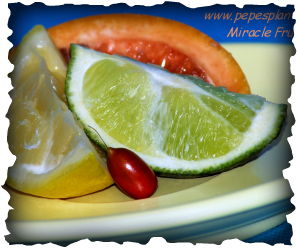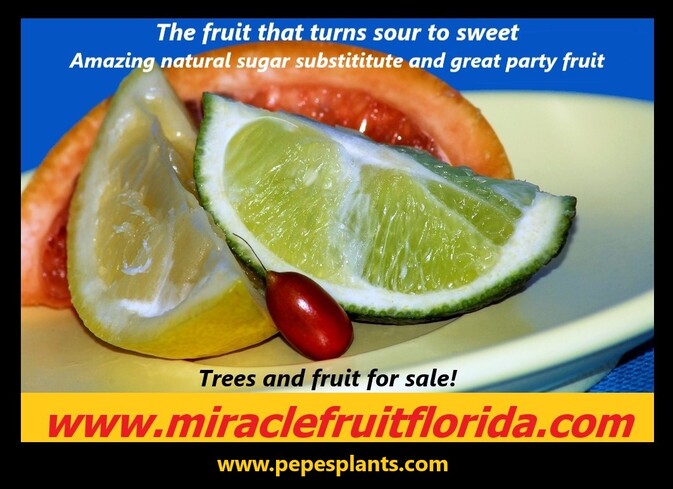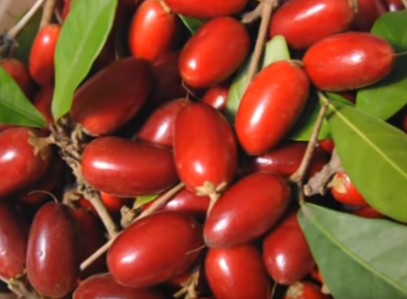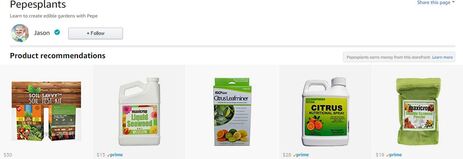Miracle Fruit
Synsepalum dulcificum

This most unusual fruit has a remarkable and miraculous effect you will never forget! After you taste this amazing berry lemons and other sour foods you taste become sweet, as if sugar had been added. This magical experience is unforgettable!
A natural chemical in the fruit masks the tongue’s sour taste buds. What causes the miracle? The fruit has a unique taste changing glycoprotein that inhibits your taste buds perception of sour taste. The sweet sensation lasts for half an hour to a few hours.
Mr. David Fairchild introduced the fruit to the United States in the early 20th century. Mr. Bill Whitman was the first to grow the plant successfully in the United States.
This small, evergreen plant is considered a shrub and grows very slowly. You can easily keep your Miracle Fruit Plant in a container. They grow to a height of 4-6 ft in a container and between 10-15 ft in its natural habitat. A seven year old plant might be only 4-5 feet tall. This shrub forms an oval to pyramidal shape and can be trained as a standard tree.
The fruit is a bright scarlet with tiny one inch football-shaped fruits. The fruit has very little flavor, slightly sweet and pleasant. The large seed has little pulp.
The plant starts fruiting when about sixteen inches tall. It produces fruit practically year around. In its native habitat, two large crops are produced yearly after heavy rains. The plants produce fruit from the flowers within thirty to forty five days.
Miracle fruit plants are easy to grow as long as you grow them in part shade and keep the soil moist. They also love acidic soil and grow poorly in alkaline soils.
Be sure to plant them in rich, well-drained soils, with lots of peat moss, and provide micro nutrients on a regular basis.
Ready to buy your plant? Click to shop:
Tips: More Info Click Here
Your plant will prefer growing at 75 - 85 degrees F. They will be okay at temperatures above 45 degrees. Plants will suffer greatly and will die if temperatures are in the low 30's degrees! During cool weather below 75 degrees be sure to ease up on watering. Cool weather and wet soil, cause many problems and may kill your plant!
When container growing your miracle fruit plant or any other acid loving plant remember this. Be sure to avoid the use of any clay containers. Clay leaches calcium minerals into the soil and this increases the pH. Also clay will breathe and the soil will dry out faster. That may be a bad situation for plants that love moist soil.
A natural chemical in the fruit masks the tongue’s sour taste buds. What causes the miracle? The fruit has a unique taste changing glycoprotein that inhibits your taste buds perception of sour taste. The sweet sensation lasts for half an hour to a few hours.
Mr. David Fairchild introduced the fruit to the United States in the early 20th century. Mr. Bill Whitman was the first to grow the plant successfully in the United States.
This small, evergreen plant is considered a shrub and grows very slowly. You can easily keep your Miracle Fruit Plant in a container. They grow to a height of 4-6 ft in a container and between 10-15 ft in its natural habitat. A seven year old plant might be only 4-5 feet tall. This shrub forms an oval to pyramidal shape and can be trained as a standard tree.
The fruit is a bright scarlet with tiny one inch football-shaped fruits. The fruit has very little flavor, slightly sweet and pleasant. The large seed has little pulp.
The plant starts fruiting when about sixteen inches tall. It produces fruit practically year around. In its native habitat, two large crops are produced yearly after heavy rains. The plants produce fruit from the flowers within thirty to forty five days.
Miracle fruit plants are easy to grow as long as you grow them in part shade and keep the soil moist. They also love acidic soil and grow poorly in alkaline soils.
Be sure to plant them in rich, well-drained soils, with lots of peat moss, and provide micro nutrients on a regular basis.
Ready to buy your plant? Click to shop:
Tips: More Info Click Here
Your plant will prefer growing at 75 - 85 degrees F. They will be okay at temperatures above 45 degrees. Plants will suffer greatly and will die if temperatures are in the low 30's degrees! During cool weather below 75 degrees be sure to ease up on watering. Cool weather and wet soil, cause many problems and may kill your plant!
When container growing your miracle fruit plant or any other acid loving plant remember this. Be sure to avoid the use of any clay containers. Clay leaches calcium minerals into the soil and this increases the pH. Also clay will breathe and the soil will dry out faster. That may be a bad situation for plants that love moist soil.
The Miracle Fruit Plant
By Jason “Pepe”
The Miracle Fruit Tree from West Africa is simply amazing. The natives enjoyed the benefits of the fruit for centuries. The local food supply was mostly very bland. These natives discovered that eating the small fruit made sour food taste sweet and improved other food and drinks. Today more and more people are discovering and enjoying this fruit all over the world. From San Francisco to New York, Miami and most major cities around the world, flavor tripping has become all the rage. Click to shop:
A typical flavor tripping party involves groups of people tasting many sour and other bland or just plain foods. The fun begins when lemons taste sweet as lemonade. Some even say that tobasco sauce tastes like chocolate syrup. Well I can tell you it does not! It’s hot like hell, so don’t even think about it! Many other foods and drinks do improve and taste surprisingly better. Try a sip of balsamic vinegar or taste some goat cheese and be pleasantly surprised at how tasty the goat cheese becomes. I could go on and on but won’t ruin the fun for you. You have to taste it to believe it. The only caution I offer you is that you don’t overdo it. Eating a large quantity of sour foods may upset your stomach.
In the 1960s, an attempt was made to market the active ingredient in Miracle Fruit called miraculin. Mr. Robert Harvey, a biomedical postgraduate student, founded the Miralin Company to grow the berry in Jamaica and Puerto Rico. The plan was to extract the miraculin in his United States Laboratories. Mr. Harvey targeted his marketing to diabetics. He felt very strongly that miraculin had tremendous commercial value and was a safer alternative to other non sugar sweeteners. In his research he discovered that miraculin could make diet foods taste better and with no strong aftertaste.
For several years Mr. Harvey worked closely with the Food and Drug Administration, trying to get miraculin on the market. In 1974 when miraculin was about to be launched into the market, the FDA pulled the plug on Mr. Harvey and his dream of making miraculin available to consumers. The FDA ruled that miraculin would require additional years of testing if it was to allow miraculin as a food additive. This ruling effectively put the Miralin Company out of business.
It’s difficult to understand how a berry that has been consumed for centuries and now for many years all around the world could meet this fate. Could it be that special interest like the sugar lobby played a role in the demise of Mr. Harvey’s Company?
So how does the Miracle Fruit do its magic?
The miracle berry is small it’s about ¾ inch to 1 inch. The bright red long and oblong shaped berry contains several chemical properties. The most concentrated chemical is a glycoprotein named miraculin. Miraculin binds to taste receptors in the tongue, tricking them into sensing acidic tastes as sweet. Miraculins masking effect on taste buds is temporary, typically lasting 45 minutes to an hour in most cases. To experience the effect, you would scrape some of the pulp and seed away with your teeth and tongue as you chew it. Wait about twenty minutes and start tasting. One Miracle Fruit Plant - Limited shipping area see map! Shipping Included!
So everything tastes great, right?
Well, not everything. Some foods taste great, some are unaffected and others are a little nasty. Some like beer after eating the fruit and others hate it. Everyone is different and parties can be quite fun.
Click to shop:
Grapefruit – candy
Honey Dew – brings out the soft subtle flavors
Granny Apple – best apple of your life
Broccoli – amazingly the cooked stems taste like artichoke
Plain yogurt tastes like a good fruit yogurt.
The miracle berry really is miraculous, fun and an amazing fruit tree to grow. Today more and more people are discovering this amazing miracle berry tree. The tree and its berries is fast becoming popular in diets and as a treatment for patients under going chemo treatments. The berries seem to assist in improving appetite and in removing the metallic taste from the mouth of cancer patients treated with chemo therapy.. Diabetics also use the berry to avoid sugar.
"The Miracle Berry Diet Cookbook"
This book was featured on the television show The Doctors and since then people have been calling non stop to purchase berries and ask questions on dieting with the plant. I think that the berry is fun and has amazing properties that can be very beneficial but I am not an expert on dieting with the berry. In the meantime, we have increased our production in order to keep up with the ever growing popularity of the Miracle Fruit Plant (Synsepalum dulcificum)
So the question is: The Miracle fruit berry, is it really suitable for dieting? I am going to purchase the recently released book "The Miracle Berry Diet Cookbook" by Homaru Cantu and see what that is all about. Yes, the Miracle Fruit Plant is amazing, but utilizing the berries as a full blown diet, this I am a bit skeptical about. Let me see what I learn and soon will feature more information and even a few videos for you to learn more.
From what I have read about Chef Homaru Cantu, he is a very interesting culinary magician. This Chef uses lasers and liquid nitrogen to prepare some wicked looking dishes. He even prepares a dish that looks like a lit cigar! Click to shop:









